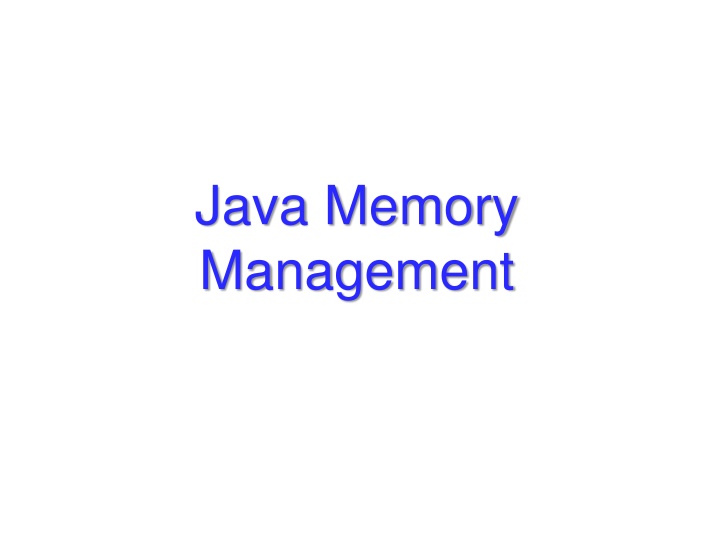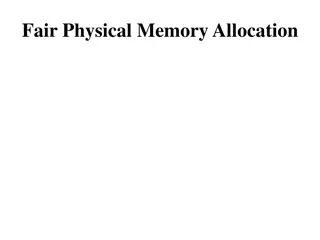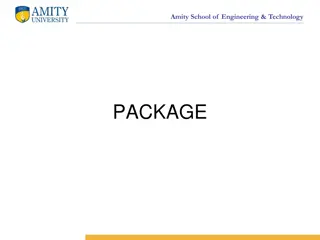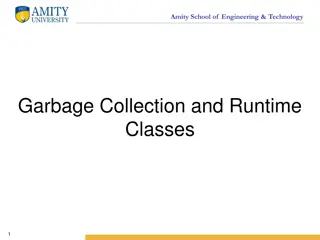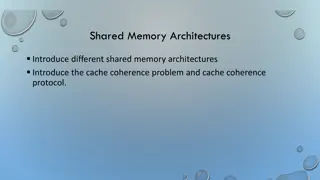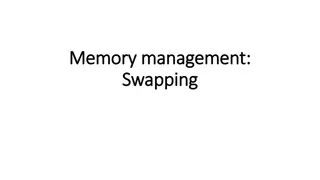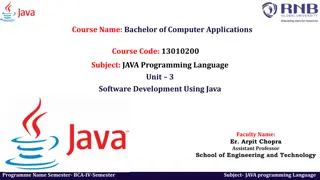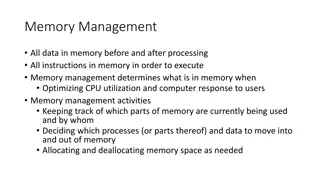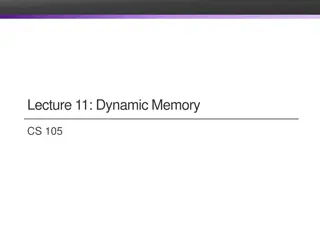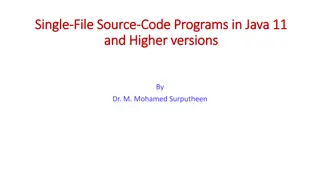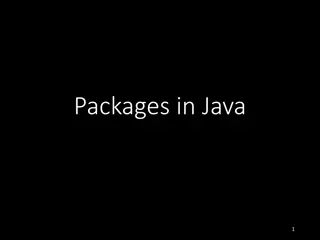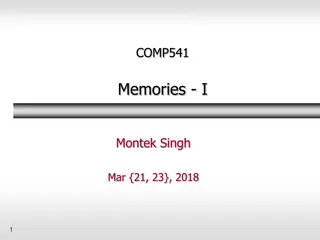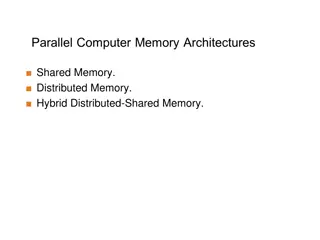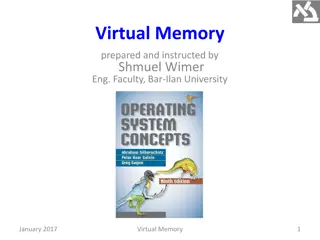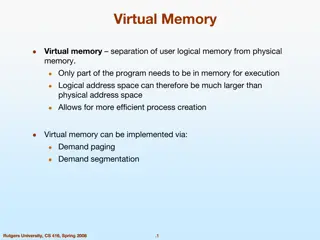Java Memory Management
Explore how memory is managed in Java programs, including memory allocation for code, objects, and execution stack. Learn about memory areas like the execution stack and heap, and understand the concept of activation records in method execution.
Download Presentation

Please find below an Image/Link to download the presentation.
The content on the website is provided AS IS for your information and personal use only. It may not be sold, licensed, or shared on other websites without obtaining consent from the author.If you encounter any issues during the download, it is possible that the publisher has removed the file from their server.
You are allowed to download the files provided on this website for personal or commercial use, subject to the condition that they are used lawfully. All files are the property of their respective owners.
The content on the website is provided AS IS for your information and personal use only. It may not be sold, licensed, or shared on other websites without obtaining consent from the author.
E N D
Presentation Transcript
Java Memory Management
Objectives Understand how the memory of a computer is used when executing a program Understand where objects, code, and execution stack are stored in memory. 8-2
Memory Allocation in Java When a program is being executed, separate areas of memory are allocated for code (classes) objects execution stack 1-3
Memory Areas Execution stack (also called runtime stack or call stack) Used to store method information needed while the method is being executed, like Local variables Formal parameters Return value Return address Heap Used to store Code Objects 1-4
Memory Allocated to a Program Execution stack Heap Activation record public static void main ( ) { } public void setNext( ) { } code and static objects objects 1-5
Memory Allocation in Java What happens when an object is created by new, as in Person friend = new Person( ); The reference variable friend has memory allocated to it in the execution stack The object is created using memory in the heap 1-6
Execution Stack Execution stack (runtime stack) is the memory space used to store the information needed by a method, while the method the is being executed When a method is invoked, an activation record (or callframe) for that methodis created and pushed onto the execution stack All the information needed during the execution of the method is stored in an activation record 1-7
Activation Record for a Method Return value Local variables Formal Parameters Return address 1-8
Activation Record An activation record contains: Address to return to after method ends Method s formal parameter variables Method s local variables Return value (if any) Note that the values in an activation record are accessible only while the corresponding method is being executed! 1-9
public class CallStackDemo { public static void m2( ) { System.out.println("Starting m2"); System.out.println("m2 calling m3"); m3(); System.out.println("m2 calling m4"); m4(); System.out.println("Leaving m2"); return; } public static void m3( ) { System.out.println("Starting m3"); System.out.println("Leaving m3"); return; } 1-10
public static void m4( ) { System.out.println("Starting m4"); System.out.println("Leaving m4"); return; } public static void main(String args[ ]) { System.out.println("Starting main"); System.out.println("main calling m2"); m2( ); System.out.println("Leaving main"); } } 1-11
Execution Stack fora Typical Calling Sequence Activation record for m3 Activation record for m2 Activation record for m2 Activation record for main Activation record for main Activation record for main 1-12 main calls m2 m2 calls m3
Execution Stack fora Typical Calling Sequence Activation record for m4 Activation record for m2 Activation record for m2 Activation record for m2 Activation record for main Activation record for main Activation record for main 1-13 Return from m3 m2 calls m4 Return from m4
Execution Stack for a Typical Calling Sequence When the main method is invoked: An activation record for main is created and pushed onto the execution stack When main calls the method m2: An activation record for m2 is created and pushed onto the execution stack When m2 calls m3: An activation record for m3 is created and pushed onto the execution stack When m3 terminates, its activation record is popped off and control returns to m2 1-14
Execution Stack for a Typical Calling Sequence When m2 next calls m4: What happens next? What happens when m4 terminates? What happens when m2 terminates? What happens when main terminates? Its activation record is popped off and control returns to the operating system 1-15
Activation Records We will now look at some examples of what is in the activation record for a method First for simple variables Then for reference variables 1-16
Example: Activation Records- Simple Variables public class CallFrameDemo1 { public static double square(double n){ double temp; temp = n * n; return temp; } } public static void main(String args[ ]) { double x = 4.5; double y; y = square(x); System.out.println("Square of " + x + " is " + y); } 1-17
Activation Records Example 1 Draw a picture of the activation records on the execution stack: What will be in the activation record for the main method? Address to return to in operating system Variable args Variable x Variable y What will be in the activation record for the method square? Address to return to in main Variable n Variable temp Return value 1-18
Discussion There will be an activation record on the execution stack foreach method called. So what other activation record(s) will be pushed onto the execution stack for our example? Which activation records will be on the execution stack at the same time? 1-19
Heap Static space: contains one copy of the code of each class used in the program also contains static objects Dynamic or Object space: Information that is stored for each object: values of its instance variables reference to its code 1-20
Static heap Dynamic heap Code Objects Activation Records Static objects Execution Stack, Call Stack, or Runtime Stack Heap
Object Creation Memory is allocated in the heap area when an object is created using the operator new Reference variables are allocated memory in the activation records in the execution stack The objects are allocated memory in the heap 1-22
public class CallFrameDemo2 { private static void printAll(String s1, String s2, String s3){ System.out.println(s1.toString( )); System.out.println(s2.toString( )); System.out.println(s3.toString( )); } public static void main(String args[ ]) { String str1, str2, str3; str1 = new String( string 1 ); str2 = new String( string 2 ); str3 = new String( string 3 ); } } printAll(str1, str2, str3); 1-23
Activation Records Example 2 Draw a picture of the execution stack and of the heap as the above program executes: Activation record for main Activation record for String constructor for str1 then popped off Activation record for String constructor for str2 then popped off Activation record for String constructor for str3 then popped off Activation record for printAll Activation record for toString for str1 then popped off Activation record for System.out.println then popped off etc. 1-24
Activation Records Example 2 What will be stored in the activation record for main? Address to return to in operating system Variable args Variable str1 Initial value? Value after return from String constructor? Variable str2 Variable str3 What will be in the activation record for printAll? 1-25
Memory Deallocation What happens when a method returns? On the execution stack: The activation record is popped off when the method returns So, that memory is deallocated 1-26
Memory Deallocation What happens to objects on the heap? An object stays in the heap even if there is no longer a variable referencing it! So, Java has automatic garbage collection It regularly identifies objects which no longer have a variable referencing them, and deallocates that memory 1-27
